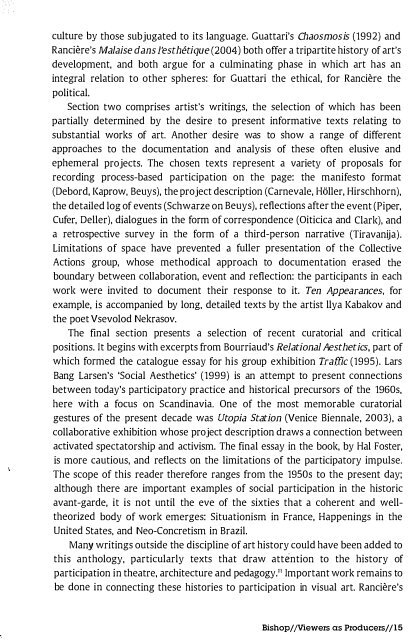Create successful ePaper yourself
Turn your PDF publications into a flip-book with our unique Google optimized e-Paper software.
culture by those subjugated to its language. Guattari's Chaosmosis (1992) and<br />
Ranciere's Malaise dans J'esthetique(2004) both offer a tripartite history of art's<br />
development, and both argue for a culminating phase in which art has an<br />
integral relation to other spheres: for Guattari the ethical, for Ranciere the<br />
political.<br />
Section two comprises artist's writings, the selection of which has been<br />
partially determined by the desire to present informative texts relating to<br />
substantial works of art. Another desire was to show a range of different<br />
approaches to the documentation and analysis of these often elusive and<br />
ephemeral projects. The chosen texts represent a variety of proposals for<br />
recording process-based participation on the page: the manifesto format<br />
(Debord, Kaprow, Beuys), the project description (Carnevale, Holler, Hirschhorn),<br />
the detailed log of events (Schwarze on Beuys), reflections after the event (Piper,<br />
Cufer, Deller), dialogues in the form of correspondence (Oiticica and Clark), and<br />
a retrospective survey in the form of a third-person narrative (Tiravanija).<br />
Limitations of space have prevented a fuller presentation of the Collective<br />
Actions group, whose methodical approach to documentation erased the<br />
boundary between collaboration, event and reflection: the participants in each<br />
work were invited to document their response to it. Ten Appearances, for<br />
example, is accompanied by long, detailed texts by the artist llya Kabakov and<br />
the poet Vsevolod Nekrasov.<br />
The final section presents a selection of recent curatorial and critical<br />
positions. It begins with excerpts from Bourriaud's Relational Aesthetics, part of<br />
which formed the catalogue essay for his group exhibition Traffic (1995). Lars<br />
Bang Larsen's 'Social Aesthetics' (1999) is an attempt to present connections<br />
between today's participatory practice and historical precursors of the 1960s,<br />
here with a focus on Scandinavia. One of the most memorable curatorial<br />
gestures of the present decade was Utopia Station (Venice Biennale, 2003), a<br />
collaborative exhibition whose project description draws a connection between<br />
activated spectatorship and activism. The final essay in the book, by Hal Foster,<br />
is more cautious, and reflects on the limitations of the participatory impulse.<br />
The scope of this reader therefore ranges from the 1950s to the present day:<br />
although there are important examples of social participation in the historic<br />
avant-garde, it is not until the eve of the sixties that a coherent and welltheorized<br />
body of work emerges: Situationism in France, Happenings in the<br />
United States, and Neo-Concretism in Brazil.<br />
Many writings outside the discipline of art history could have been added to<br />
this anthology, particularly texts that draw attention to the history of<br />
participation in theatre, architecture and pedagogy." Important work remains to<br />
be done in connecting these histories to participation in visual art. Ranciere's<br />
Bishop/ jViewers as Producers/ /15








